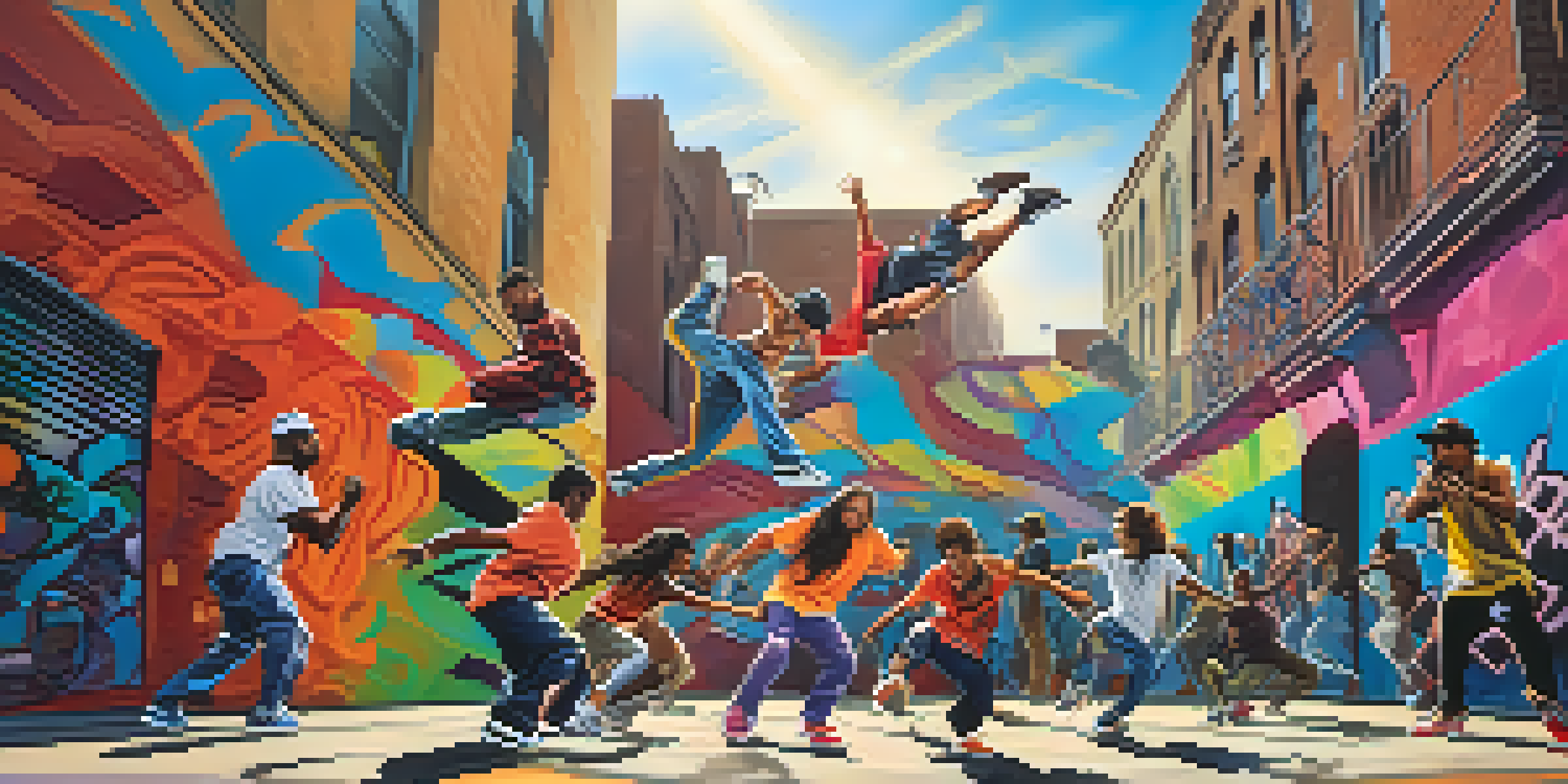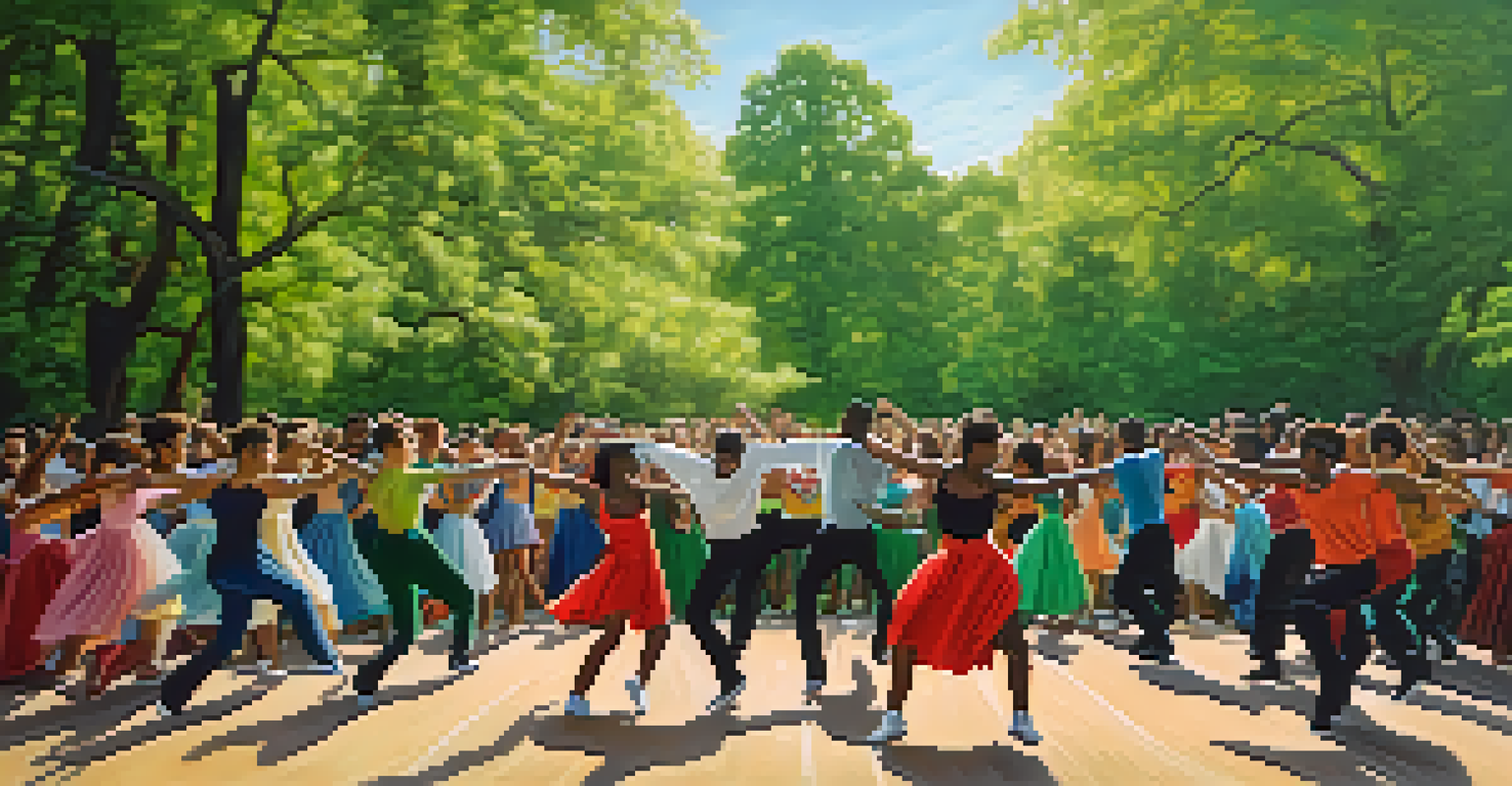The Evolution of Hip-Hop Dance in Global Youth Culture

The Roots of Hip-Hop Dance: A Cultural Movement
Hip-hop dance originated in the 1970s in the South Bronx, New York, as part of a larger cultural revolution. It emerged from street parties where DJs mixed music and dancers showcased their skills, creating an energetic and vibrant environment. This art form was more than just dance; it became a voice for marginalized communities, allowing youth to express their struggles and aspirations. As hip-hop music gained popularity, so too did the dance styles associated with it, making it a cornerstone of youth culture.
Hip-hop is more than music. It's a cultural movement, a way for young people to express themselves and their experiences.
The early styles, like breakdancing or b-boying, were characterized by acrobatic moves and intricate footwork. Dancers would often battle each other, showcasing their creativity and athleticism. This competitive aspect fostered a sense of community, as dancers supported one another and shared techniques. The influence of hip-hop dance soon spread beyond New York, capturing attention in cities across the United States and eventually around the globe.
By the 1980s, hip-hop dance was making its way into popular culture, appearing in music videos and films. This exposure not only validated the art form but also inspired a new generation of dancers. Young people were drawn to the freedom and individuality that hip-hop offered, leading to the development of diverse styles influenced by various cultures. The dance became a symbol of youth rebellion and creativity, setting the stage for its evolution.
Hip-Hop Dance Styles: From B-Boying to Krumping
Hip-hop dance encompasses various styles, each with its own unique flavor and history. B-boying, often referred to as breakdancing, focuses on ground movements and spins, requiring immense strength and flexibility. On the other hand, popping and locking emphasize sharp, robotic movements, showcasing the dancer's ability to control their body fluidly. Each style tells a different story and reflects the diverse backgrounds of its practitioners.

As the hip-hop scene evolved, new styles began to emerge, such as krumping, which originated in the early 2000s in Los Angeles. Krumping is characterized by its expressive, aggressive movements and serves as an emotional outlet for dancers. This development highlights how hip-hop dance continues to adapt and grow, reflecting the experiences and emotions of youth across different cultures and regions.
Hip-Hop Dance: A Voice for Youth
Originating in the 1970s, hip-hop dance became an empowering outlet for marginalized communities, allowing youth to express their struggles and creativity.
Moreover, the blending of hip-hop with other dance forms has fueled further innovation. Dancers often incorporate elements from jazz, contemporary, and even traditional dances, creating hybrid styles that resonate with a broader audience. This fusion not only enriches the dance community but also allows hip-hop to remain relevant and relatable to diverse groups of young people worldwide.
The Global Spread of Hip-Hop Dance: A Cultural Exchange
With the rise of the internet and social media, hip-hop dance has transcended geographical boundaries. Platforms like YouTube and TikTok have allowed young dancers from different countries to share their skills and creativity with the world. This global exposure has led to a vibrant exchange of ideas, techniques, and styles, enriching the hip-hop dance community as a whole. Dancers can now connect and collaborate regardless of their location, fostering a sense of unity.
Dance is the hidden language of the soul.
In countries like South Korea, hip-hop dance has taken on a life of its own, becoming a significant part of the youth culture. K-pop groups often incorporate hip-hop dance into their performances, showcasing intricate choreography that draws from various styles. This cross-cultural phenomenon highlights how hip-hop dance can adapt and thrive in different contexts, influencing and being influenced by local traditions and trends.
The worldwide popularity of hip-hop dance has also led to the establishment of international competitions, such as the World Hip-Hop Dance Championship. These events not only celebrate talent but also promote cultural understanding among participants from diverse backgrounds. By sharing their individual stories and experiences through dance, these young performers contribute to a global narrative that celebrates creativity and resilience.
Hip-Hop Dance in Education: Empowering Youth
Hip-hop dance has found its way into educational settings, offering youth a creative outlet and a means of self-expression. Many schools and community programs now incorporate hip-hop dance classes, recognizing its potential to engage students and promote teamwork. These classes often focus on building confidence, discipline, and creativity, essential skills for personal and academic success.
Through hip-hop dance, young people learn the importance of collaboration and respect for one another. Group choreography encourages dancers to communicate, share ideas, and support each other's growth. This sense of community fosters a positive environment, making dance a powerful tool for social change and personal development.
Global Influence and Cultural Exchange
The rise of social media has allowed hip-hop dance to transcend borders, fostering collaboration and innovation among dancers worldwide.
Moreover, hip-hop dance can serve as a bridge between cultures, allowing students from different backgrounds to connect and learn from one another. By participating in dance programs, youth can explore their identities and gain a deeper understanding of the cultural significance of hip-hop. This educational aspect of hip-hop dance not only empowers individuals but also strengthens the bonds within communities.
Social Movements and Hip-Hop Dance: A Voice for Change
Hip-hop dance has long been intertwined with social movements, serving as a powerful medium for expressing the struggles and aspirations of marginalized communities. In recent years, dancers have used their art to raise awareness about issues such as racial inequality, police brutality, and climate change. This activism highlights the role of hip-hop dance as a form of resistance, empowering youth to take a stand and advocate for their rights.
Dance crews and collectives often participate in protests and community events, using their performances to convey messages of solidarity and hope. Through choreography, dancers can articulate their feelings and perspectives in a way that resonates deeply with audiences. This ability to blend artistry with activism makes hip-hop dance a vital tool for promoting social justice and equality.
Furthermore, the visibility of hip-hop dance in mainstream media has amplified these messages, inspiring young people to engage in activism. As dancers showcase their talents on platforms like television and social media, they encourage their peers to use their voices and creativity for positive change. This intersection of dance and activism is a testament to the enduring power of hip-hop as a catalyst for transformation.
The Future of Hip-Hop Dance: Innovation and Adaptation
As hip-hop dance continues to evolve, it faces both challenges and opportunities in the digital age. The rapid pace of technological advancements has changed how dance is created, shared, and consumed. With the rise of virtual classes and online competitions, dancers can connect with audiences and fellow performers like never before. However, this shift also raises questions about authenticity and the preservation of hip-hop's cultural roots.
Young dancers are now blending traditional techniques with modern influences, leading to innovative choreographies that push the boundaries of hip-hop dance. This experimentation reflects the diverse experiences and backgrounds of the current generation, making hip-hop a living, breathing art form. As new styles emerge, they challenge the notion of what hip-hop dance can be, creating exciting possibilities for the future.
Empowerment Through Education
Hip-hop dance classes in schools promote teamwork and self-expression, helping young people build confidence and connect across cultures.
Ultimately, the future of hip-hop dance lies in its ability to adapt while staying true to its roots. As long as dancers continue to share their stories and connect with one another, hip-hop will remain a vital part of global youth culture. The ongoing evolution of this art form ensures that it will continue to inspire and empower generations to come.
Celebrating Diversity: The Role of Hip-Hop Dance in Inclusion
Hip-hop dance is a celebration of diversity, showcasing the unique influences and backgrounds of its practitioners. As an inclusive art form, it welcomes individuals from all walks of life, encouraging them to express themselves authentically. This sense of belonging fosters a supportive community where dancers can learn from one another, share their stories, and create together.
The emphasis on individuality in hip-hop dance allows for the exploration of various cultures and experiences. Dancers often incorporate elements from their heritage, enriching the overall dance landscape. This blending of styles not only honors the art form's roots but also promotes cultural exchange and understanding among participants.

By embracing diversity, hip-hop dance empowers young people to take pride in their identities and express their unique perspectives. This inclusivity is essential for creating a vibrant and dynamic dance community that reflects the world around us. As hip-hop continues to evolve, its ability to unite and inspire individuals from different backgrounds will remain a powerful testament to its impact on global youth culture.